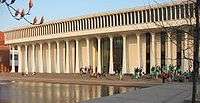Wascana Centre
| Wascana Centre | |
|---|---|
| Type | Public park |
| Location | Regina, Saskatchewan |
| Coordinates | 50°25′57″N 104°36′24″W / 50.4325°N 104.6068°WCoordinates: 50°25′57″N 104°36′24″W / 50.4325°N 104.6068°W |
| Area | 9.3 square kilometres (2,300 acres) |
| Created | 1962 (formally established) |
| Operated by | Wascana Centre Authority |
| Status | Open all year |
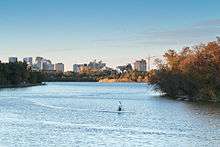
Wascana Centre (formally established in 1962) is a 9.3 square kilometre (2,300 acre) park built around Wascana Lake in Regina, Saskatchewan. It brings together lands and buildings owned by the City of Regina, University of Regina, and Province of Saskatchewan, each of which is represented on the board of directors, and contains government, recreational, cultural, educational and environmental facilities.
It was designed by the Seattle architect Minoru Yamasaki — famous for design of the original World Trade Center in New York City — in tandem with his plans for the Regina Campus of the University of Saskatchewan.[1] His stark modernist plan for the University, which was from the outset a matter of contention as to its suitability for the featureless Regina plain, is evident in the first three buildings of the campus, the laboratory, classroom and library buildings, but the laboratory and library buildings have been substantially altered and the original master plan for the campus has been revamped over time.
History

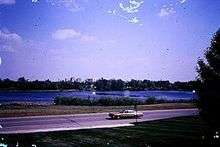
The name "Wascana" is derived from the Cree word Oscana meaning "pile of bones" in reference to the plains bison bones scattered around Wascana Creek before the area was populated by non-indigenous people.
It was decided to establish a new campus in Regina for the University of Saskatchewan beyond the College Avenue buildings dating back to 1911, beginning as a private Methodist secondary school which became the College Avenue Campus. Minoru Yamasaki was commissioned in 1961 to prepare a 100-year master plan for the whole of a Wascana Centre including the new university complex.[1] Yamasaki's vision has largely been adhered to, notwithstanding some controversy over the years as to the suitability of his stark modernist buildings for the featureless Regina plain.
Wascana Lake was originally created in 1883 by damming Wascana Creek between Angus and Rae Streets, 1½ blocks west of the present Albert Street dam and bridge, to provide a "stock watering hole" — the rolling stock of the CPR, that is. The Lake was soon turned to recreational use and Reginans took to the lake for sailing and canoeing. Its size was slightly reduced in 1908 when a new dam and bridge were constructed in their present location.
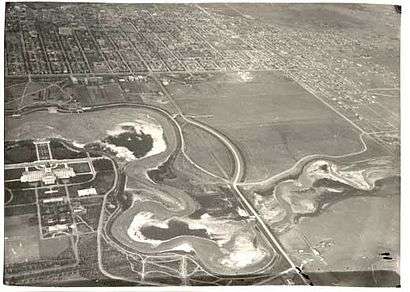
The lake continued for a time to be used as a domestic water supply and for stock watering; it also supplied the new legislative building.[2] A longer term effect resulted, however, when lake water was used to cool machinery in the power plant (now the Powerhouse Museum) that was built in the eastern sector. Heated water returned to the lake, causing that sector to remain ice-free through the winter, and several species of migratory birds made it their year-round habitat. The eastern sector of the lake is now a waterfowl sanctuary.
Wascana Lake was drained and deepened in the 1930s as part of a government relief project. 2,100 men widened and dredged the lake bed and created two islands using only hand tools and horse-drawn wagons.[2]
During the fall and winter of 2003-2004, Wascana Lake was again drained and dredged to deepen it by an average of about 5 metres (16 ft). The Big Dig, as it was known locally, was primarily to decrease aquatic weed growth, improve water quality, and allow more competitive and recreational canoeing and paddling during the summer months. The Big Dig also included the addition of a new island and general re-landscaping around the lake. The dredging was completed in mid-March 2004, in time for the spring runoff. The lake includes several small islands: Willow Island, Spruce Island, Pine Island, Goose Island and Tern Island.
The Wascana Racing Canoe Club and Wascana Centre have hosted the 2006 Canadian Sprint CanoeKayak National Championships in 2006 and 2010 and will host the event again in 2014 from August 19 to 24. Wascana Lake is also the venue for the canoe/kayak event at the 2014 North American Indigenous Games being hosted in Regina being held in July.
Statistics
Wascana Centre promotional literature touts it as being larger than New York City's Central Park at 843 acres (3.4 km2) and Vancouver's Stanley Park at 1,000 acres (4 km2) and as the fourth largest urban park in Canada.
Amenities
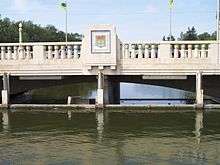
Wascana Centre includes a Waterfowl Park that provides a refuge for geese, ducks and other birds, some of which do not fly south for the winter. Speakers' Corner on the north shore of Wascana Lake features gas lamps from London and birch trees from Runnymede Meadow where King John signed the Magna Carta in 1215 .
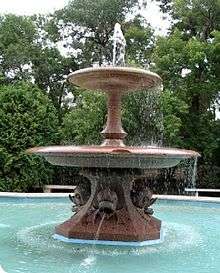
To the immediate east of the legislative building is Trafalgar Fountain, one of a pair of fountains in Peterhead granite designed by Charles Barry and built by McDonald & Leslie, Aberdeen. The fountain stood in London, England's Trafalgar Square from 1845 to 1939, when King George VI and Queen Elizabeth spent six weeks in May and June touring Canada in May and June, including Regina. The twin of this fountain is located in Confederation Park, Ottawa.[3][4] This one has been dedicated to the 1882 founding of the North-West Mounted Police Headquarters in Regina.
Wascana Centre contains many facilities, amenities and attractions, several long-predating the Centre's establishment. They include the following:
- three museums, including the Royal Saskatchewan Museum and the Saskatchewan Science Centre;
- the Conexus Arts Centre (known from 1970 till 2006 — and still largely known — as the Saskatchewan Centre of the Arts) concert hall and theatre complex;
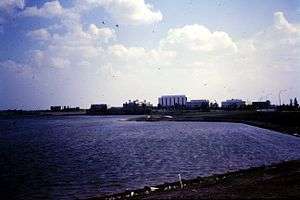
- the "new" 1966 campus of the University of Regina (formerly the University of Saskatchewan, Regina Campus);
- the Regina Research Park;
- the Lakeshore Tennis Club
- the Regina College campus of the University of Regina;
- the Regina Conservatory of Music (in the old girls' residence wing of the Regina College building);
- the Darke Hall theatre and concert venue on the Regina College campus of the University of Regina;
- the MacKenzie Art Gallery;
- the CBC's Regina Broadcast Centre, which houses CBK (AM), CBK-FM, and CBKT
- the Canada-Saskatchewan Soundstage; and
- the provincial Legislative Building.
- Wascana Waterfowl Park, Wascana Lake east of Broad Street bridge. "Each April, about 225 pair of Canada Geese begin nesting in the Park. Most nest on man-made Goose Island which provides protection for them during nesting. The Wascana Waterfowl Park also has resident populations of mammals including muskrat , mink, Jack rabbit, Richardson's ground squirrel, red fox, and beaver."[5]
- the Wascana skateboard park located just east of the Saskatchewan Science Centre.
Immediately to the east of the originally Methodist Regina College complex is the former Anglican Diocesan property. This has not been absorbed into the Wascana Centre, but is being commercially developed with considerable strictures to maintain the historic ecclesiastical structures and green space. It contains the former St Chad's College (originally an Anglican theological seminary, which formally vacated to the University of Saskatchewan in Saskatoon), the Qu'Appelle Diocesan School (the Anglican Sisters of St John the Divine maintained St Chad's private girls' school on the premises until 1970 but the Anglican Church, like the United Church, no longer maintains any secondary or tertiary education involvement in Regina); the former Bishops Court and assorted ecclesiastical structures. The entire property was sold to the provincial Crown in the 1970s and has now been further sold for residential and commercial development.The Centre also contains attractive venues for cross country skiing and skating during winter and tennis, bicycling, running, and motorized water sports during summer. It is also the training centre for Wascana Racing Canoe Club and the Regina Rowing Club. Much of the lake-bottom dredgings from the deepening of Wascana Lake were added to an existing artificial hill on the north shore of the lake, across from the new campus of the University, creating a much larger winter toboggan run.
When Regina hosted the 2005 Canada Summer Games, most of the event venues and athlete accommodations were located in the Wascana Centre.
Wascana Lake Urban Revitalization Project
The Wascana Lake Urban Revitalization Project, known locally as the Big Dig, was an $18 million project to deepen Wascana Lake. The project took place during the winter of 2004.
Background
Wascana Lake was drained in the 1930s as part of a government relief project; 2,100 men widened and dredged the lake bed and created two islands using only hand tools and horse-drawn wagons. During the late 20th century, sediment accumulating at the bottom of the lake eventually reduced its depth by 35 per cent, which had reached 1.5 metres by 2003. In addition, there was an abundance of weeds throughout the lake.
The funding of the project was jointly shared by the federal, provincial and municipal governments. Half of the funding was provided by the Government of Canada while the Province of Saskatchewan and the City of Regina committed $5 million and $4 million respectively.
Excavation
Excavation of the lake was performed by Dominion Construction of Regina and Broda Construction of Kamsack. The lake was dredged to an overall depth of 5.5 metres with a deeper section of 7.5 metres serving as a fish habitat. Over 1.3 million cubic metres of soil was removed from the lake bottom between 6 January and 21 March with crews working 24 hours a day.
Additional construction
In addition to the deepening of the lake, construction crews created additional features.
A new island was created from the Broad Street Bridge abutment. The island includes a bridge for pedestrian access, as well as a pedestrian path and a waterfall and provides a great location for spectator viewing of canoe/kayak and rowing races hosted on Wascana Lake. In 2014, Wascana Racing Canoe Club, the Regina Rowing Club and Wascana Centre Authority, with significant financial support from Tourism Regina, completed the construction of a Finish Line Tower on Pine Island. This makes Wascana Lake a world-class venue for competitive canoe/kayak and rowing competitions.
Crews installed a dozen aeration filters throughout the lake to produce oxygen to the water in order to improve its life-supporting quality. A circular fountain was erected in the center of the lake opposite the legislative building.
The creation of a new pathway adjacent to the Albert Street Bridge now connects the paths on the north and south shores, providing a complete walkway around the lake. In addition, the south pedestrian path now passes under the Broad Street Bridge connecting the east and west recreation areas.
Gallery
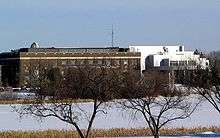 Saskatchewan Science Centre on northeast side of Wascana Lake
Saskatchewan Science Centre on northeast side of Wascana Lake The Forgotten dig
The Forgotten dig- The big dig
- The mighty Wascana
- Wascana Centre Historical Plaque
References
- 1 2 Fletcher, Tom. "The Work of Minoru Yamasaki," New York Architecture Images and Notes. Internet: http://www.nyc-architecture.com/GON/GON001G.htm.
- 1 2 Riddell, W. A. The Origin and Development of Wascana Centre. Regina, 1962.
- ↑ The Art Fund - A Pair of Fountains from Trafalgar Square
- ↑ Timbs, J. (1855). Curiosities of London: Exhibiting the Most Rare and Remarkable Objects of the Metropolis. David Bogue, London. Retrieved 2007-11-12.
- ↑ "Wascana WaterFowl Park." http://www.inregina.com/BusinessListings/tabid/87/ctl/Listings/CategoryID/5/ListingID/387/mid/463/Default.aspx
